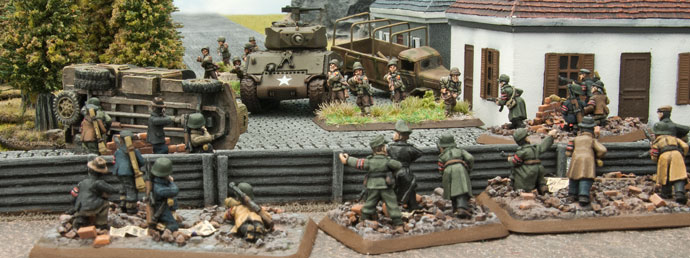
Wargames are a variant of boardgames that are based around the idea of replicating a war/battle (wth any setting, from historical events to fantasy and even improbable 'what if' scenarios in history) with as much detail, precision and respect for the combatants (assuming it's based on real events) as possible, while having to deal with the limitations of the tabletop. Most wargames are easily able to skirt around these limitations, however, so don't let that sway you away from a very entertaining hobby.
Most wargames, unlike boardgames, are fairly standardised in terms of how they are set up and developed. Compare this to boardgames, which CAN have similar elements in them (cards, a board etc.) but use them in radically different ways and provide very different games because of this. That isn't to say that all wargames are the same - they each have their own unique twist on the formula which provides a unique strategic twist depending on the setting and scale of the battles being replicated.
Although there is a large collection of wargames that use cardboard tokens and represent conflict from the perspective of, say, a general as opposed to a field commander, there is a very different style of wargame based around fighting as if you were in the battle, (see image below for reference) which from here on out on this page will be the style of wargame I'm referring to when a wargame is mentioned.

Most wargames are miniature-based, meaning that you get little 'miniature' figures that represent soldiers, artillery, cavalry and other combatants/war machines used in battle. Almost always, these miniatures come unpainted and unassembled, meaning that you have to paint them and assemble them yourself. I know first hand that this can be quite daunting, but this approach means that personalising your armies is incredibly easy (compared to something like a video game) and even just making them as accurate to their source material as possible is an incredibly gratifying experience. If you do want to take up painting miniatures, it's worthwhile to know what you're doing.
Once your miniatures are ready, you'll want a good table to play on. The best tables for war gaming are built around that purpose, and therefore are usually entirely covered in scenery. However, such an endeavour isquite expensive and while it technically isn't necessary, it can become a very interesting centrepiece for your collection(s) and does provide a sense of realism that most would appreciate. If, like I mentioned earlier, it's too dear/daunting, having something as simple as just some buildings/ruins scattered around a regular table does perfectly well.
If you are interested in making a wargaming table, or just some 'scatter pieces' (non-permanent scenery pieces that provide strategic/aesthetic complexity e.g. sandbags or some trees) to spice up things, check out The Terrain Tutor, a wargamer who provides in-depth tutorials about making effective terrain while still being cost effective (compared to other methods).